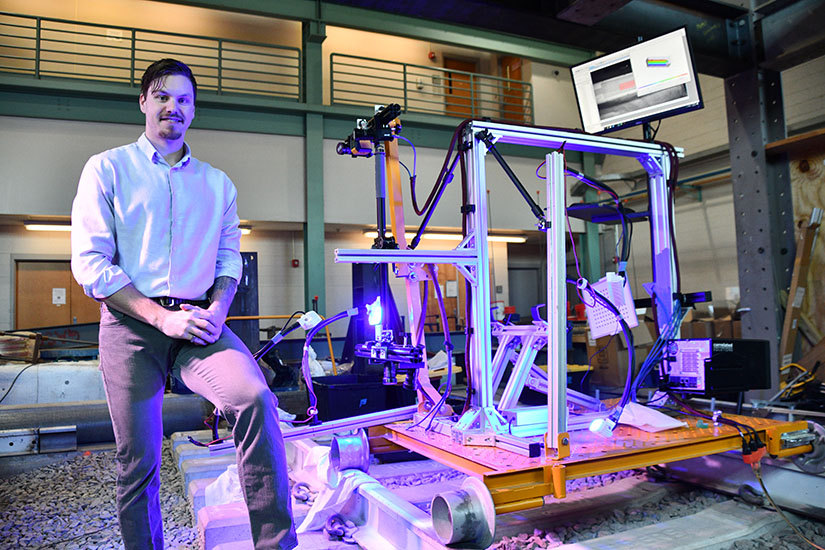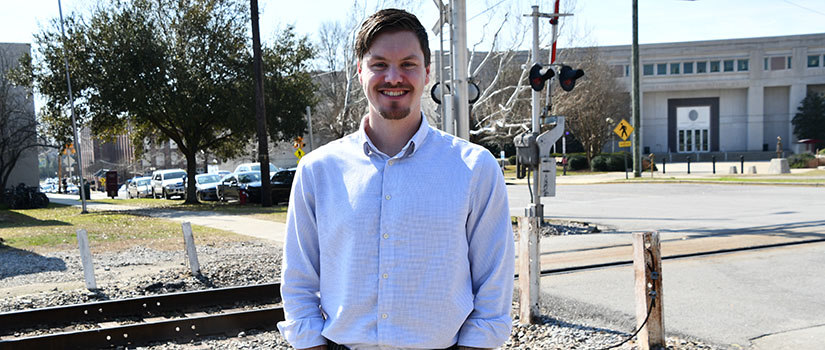Brennan Gedney is utilizing advanced structural inspection techniques for early damage detection and timely maintenance of railway infrastructure.
Last summer, the National Transportation Safety Board released a report blaming a freight railroad company inspectors for not flagging poor track conditions that caused the derailment of an Amtrak train in Montana that killed three people and injured 49 others in 2021. Federal investigators also found that a train inspector’s excessive workload likely prevented a timely examination of the tracks before the derailment.
This example highlights a critical problem in infrastructure maintenance: inefficient or rushed manual inspections often miss small types of damage. These small damages grow quickly under the extreme loads of trains and eventually lead to broken rail and train derailments.
Ph.D. candidate Brennan Gedney is targeting this critical gap by applying advanced structural damage detection techniques to increase the efficiency and accuracy of railway inspections. He recently received a scholarship and award to help supplement this work.
Gedney is the recipient of the 2023 Railway Engineering-Maintenance Suppliers Association (REMSA) Railway Engineering Education scholarship, and the 2024 InnoTrans Career Award. REMSA offers one $10,000 education award every year for eligible applicants pursuing additional education that would allow them to work successfully and grow within the rail construction and maintenance industry.
“The focus of the scholarship is to support practical research that the industry needs. Receiving this indicates that I'm on the right track by doing work that not just advances the state of knowledge but is applicable to improving the railway industry,” Gedney says.
REMSA also presents a “Career Award” that sponsors one student from a U.S. institution to participate in career development activities at the InnoTrans 2024 international conference this September in Berlin. InnoTrans is the largest railway conference in the world and is held every two years.
“I’m not only representing USC but the U.S. since they [InnoTrans] only give one award,” Gedney says. “It will be great to talk about what our rail industry is doing and what we're working towards. It's exciting to be selected to represent everything we're doing here.”
Gedney earned his undergraduate degree in civil engineering from the University of South Carolina in 2017. After serving in the U.S. Navy, Gedney returned to USC for graduate studies under Civil and Environmental Engineering Professor Dimitris Rizos, who was his undergraduate advisor. Gedney earned his master’s degree in structural engineering in 2022 before embarking on his Ph.D. studies later that year.
Gedney’s research has been related to structural engineering since he was an undergrad, and he continues to apply his work with Rizos and his Advanced Railroad Technology Group. The group’s projects focus on creating innovative, inexpensive and non-destructive methods of monitoring the condition and performance of railway infrastructure.

Gedney currently works on several research projects, focusing on analyzing structural responses with signal processing, to determine the structural condition. One project, overseen by Rizos and funded by the Federal Railroad Administration, is developing a prototype system to estimate rail neutral temperature by using digital image correlation to monitor the conditions that affect the structural health of railway track and impact safety operations. As a railway rail heats up from solar radiation or seasonal temperature variations, the rail thermally expands and induces compressional stress that can lead to buckling. An accurate assessment of the risk of buckling is needed, and this work meets that need in a non-destructive, non-contacting, and non-disruptive manner.
“The track needs to be maintained to keep the risk of buckling low because dangerous derailments occur when the track buckles,” Gedney says. “Currently, there are no ways to quantify that buckling risk without destroying or severely disrupting the track and rail traffic in some way, which is expensive. Our approach is non-destructive and non-contacting and allows us to accurately monitor the state of stress in the rails in an efficient and inexpensive way.”
Gedney is also working on his doctoral dissertation by developing an innovative structural damage detection technique using structural vibration responses. The method generally aims to identify structural damage in the early stages of development when it is possible to repair quickly and easily. Once the damage grows, expensive renovations or structural element replacements are needed to keep the structure in service. Gedney’s dissertation includes applying his technique to detect hidden internal rail defects that do not manifest on the surface.
“I am working on a method that interprets structural vibration responses, usually displacements or accelerations. With an appropriate signal processing algorithm, even the smallest types and least severe damages become apparent in the structural response,” Gedney says. “This makes inspections more efficient, less reliant on manual examinations, and reduces the complexity and number of sensors needed.”
According to Rizos, Gedney’s research involves a combination of physics-based and data-driven method development, experimental and field testing, data acquisition, and advanced image processing techniques. His attention to detail and approach to data analysis ensures the reliability and accuracy of his findings.
“He has impressed me with his critical thinking, innovation, perseverance and dedication to succeed in the high goals he sets for himself,” Rizos says. “When I asked him to lead the activities in the indoor rail track testing laboratory facility and manage a group of undergraduate researchers, he has clearly demonstrated his leadership, organization and communications skills stemming from his U.S. Navy background.”
Gedney is planning to complete his doctoral work in December 2025. He anticipates working in the rail industry and hopes to see his work implemented for improved safety.
“I most likely see myself working in applied research in a startup or research group of a larger company,” Gedney says. “A lot of the work I’m currently doing is specific in application, and we're making progress on developing techniques and prototypes that will significantly improve inspections on railways.”
